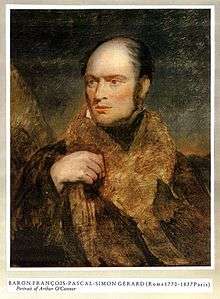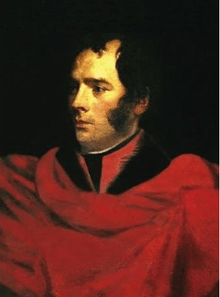Arthur O'Connor (United Irishman)
Arthur O'Connor (4 July 1763 – 25 April 1852), was a United Irishman and later a general in Napoleon's army.
Arthur O'Connor | |
|---|---|
 O'Connor in French military uniform | |
| Member of Parliament for Philipstown | |
| In office 1790–1795 | |
| Preceded by | John Toler Henry Cope |
| Succeeded by | William Sankey John Longfield |
| Personal details | |
| Born | 4 July 1763 Bandon, County Cork |
| Died | 25 April 1852 (aged 88) |
| Spouse(s) | Alexandrine Louise Sophie de Caritat de Condorcet
( m. 1807; |
| Relations | Roger O'Connor (brother) |
| Children | 5, including Daniel |
Early life


O'Connor was born near Bandon, County Cork on 4 July 1763 into a wealthy Irish Protestant family. Through his brother Roger O'Connor, the author of the Chronicles of Eri who shared his politics, he was an uncle to Roderic O'Connor, Francisco Burdett O'Connor, and Feargus O'Connor among others.[1] His other two brothers, Daniel and Robert, were pro-British loyalists.[2]
As a young man, he embraced the Republican movement early on as he was encouraged by the American Revolution overseas. After his oldest brother Daniel got into debt, his brother Roger bought out his inheritance. The family's political and financial conflicts were only deepened when their sister Anne committed suicide, after having been forbidden by the family from marrying a Catholic man she was in love with.[2]
Career
From 1790 to 1795 he was a Member of Parliament in the Irish House of Commons for Philipstown. The Irish House of Commons was part of the colonial parliament that sat in College Green. O'Connor was also a member of the Kildare Street Club in Dublin.[3]
United Irishmen
In 1796, he became a member of the Society of United Irishmen. He and Lord Edward Fitzgerald petitioned France for aid in support of an Irish revolution. While traveling to France he was arrested alongside Father James Coigly, a Catholic priest, and three other United Irishmen. Coigly, who found to be carrying an incriminating letter, was hanged, whereas O'Connor was acquitted. He was re-arrested immediately and imprisoned at Fort George in Scotland along with his brother Roger. On his way to confinement,[4] he distributed a poem, which, seeming to recant his republican beliefs, with verses re-ordered, was instead a ringing re-affirmation of them:[5]
The pomp of courts, and pride of kings,
I prize above all earthly things;
I love my country, but my king,
Above all men his praise I'll sing.
The royal banners are display'd,
And may success the standard aid:
I fain would banish far from hence
The Rights of Man and Common Sense.
Destruction to that odious name,
The plague of princes, Thomas Paine,
Defeat and ruin seize the cause
Of France, her liberty, and laws.[6]
Life in France
O'Connor was released in 1802 under the condition of "banishment".[7] He travelled to Paris, where he was regarded as the accredited representative of the United Irishmen by Napoleon who, in February 1804, appointed him General of Division in the French army. General Berthier, Minister of War, directed that O'Connor was to join the expeditionary army intended for the invasion of Ireland at Brest.
When the plan fell through, O'Connor retired from the army. He offered his services to Napoleon during the Hundred Days. After Napoleon's defeat he was allowed to retire, becoming a naturalised French citizen in 1818. He supported the 1830 revolution which created the July Monarchy, publishing a defence of events in the form of an open letter to General Lafayette. After the revolution he became mayor of Le Bignon-Mirabeau. The rest of his life was spent composing literary works on political and social topics.[8] Arthur and his wife continued the efforts of her mother, Sophie de Condorcet (who was herself an accomplished translator of Thomas Paine and Adam Smith), to publish her father's, the Marquis de Condorcet, works in twelve volumes between 1847 and 1849.[9]
Personal life
In 1807, although more than twice her age, O'Connor married Alexandrine Louise Sophie de Caritat de Condorcet (b 1790/1-1859), known as Eliza, the daughter of the scholar the Marquis de Condorcet and Sophie de Condorcet.[10][11][12][13] His wife gave birth to five children, three sons and two daughters, almost all of whom predeceased him.[13] Only one son, Daniel, married and had issue.[14]
- Daniel O'Connor (1810–1851), who married Ernestine Duval du Fraville (1820–1877), a daughter of Laurent-Martin Duval, Baron Duval du Fraville, in 1843.[15] She died at Cannes in 1877.[16]
O'Connor died on 25 April 1852. His widow died in 1859.[17]
Descendants
His descendants continued to serve, as officers, in the French army and still reside at Château du Bignon.[17] Through his only surviving son Daniel, he was a grandfather of two boys, Arthur O'Connor (1844–1909), who served in the French army, and Fernand O'Connor (1847–1905), a Brigade General who served in Africa and was made a Knight of the Legion of Honour.[18] His grandson, Arthur, married Marguerite de Ganay (1859–1940), a daughter of Emily and Etienne, Marquis de Ganay, in 1878. They had two daughters, Elisabeth O’Connor, the wife of Alexandre de La Taulotte; and Brigitte Emilie Fernande O'Connor (1880–1948), who in 1904 married the Comte François de La Tour du Pin (1878–1914), who was killed ten years later at the Battle of the Marne.[19][lower-alpha 1]
Publications
- The Measures of Ministry to Prevent a Revolution: Are the Certain Means of Bringing it on (1794)
- A Letter to the Earl of Carlisle, Occasioned by His Lordship's Reply to Earl Fitzwilliam's Two Letters, Exhibiting the Present State of Parties in Ireland (1795)
- State of Ireland (1798)
- Paddy's Resource: Being a Select Collection of Original and Modern Patriotic Songs: : Compiled for the Use of the People of Ireland (1798)
- The Portrait of an Irish Executive Director, by Himself and His Friends (1799)
- État actuel de la Grande-Bretagne (1804)
- Lettre du général Arthur Condorcet O'connor au général La Fayette: sur les causes qui ont privé la France des avantages de la révolution de 1830 (1831)
- État religieux de la France et de l'Europe d'après les sources les plus authentiques avec les controverses sur la séparation de lÉglise et de l'État, Volumes 1 à 2 (written with François-André Isambert and Charles Lasteyrie, 1844)
- Le monopole, cause de tous les maux (1849)
- To the People of Ireland
See also
References
- Notes
- They had two sons and one daughter: Aymar de la Tour du Pin, Marquis de la Tour du Pin-Chambly (1906–1979), Patrice de la Tour du Pin (1911–1975),[20] and Philis de la Tour du Pin.
- Sources
- Casey, Brian (2013). Defying the Law of the Land: Agrarian Radicals in Irish History. The History Press. p. 51. ISBN 978-0-7524-9952-9.
- "Arthur O'Connor United Irishman". www.hayterhames.co.uk. Jane Hayter-Hames. Retrieved 15 May 2020.
- Thomas Hay Sweet Escott, Club Makers and Club Members (1913), pp. 329–333
- The Casket: Flowers of Literature, Wit and Sentiment, Vol. 5. Philadelphia. 1830. p. 234.
- Hitchens, Christopher (15 July 2006). "Bones of Contention". The Guardian. Retrieved 3 February 2013.
- The Monthly Mirror, VII (February 1799), p. 127. The author was identified as Arthur O'Connor in a letter to the editor of Drakard's Paper (later The Champion) on 14 April 1813.Retrieved 3 Feb. 2013.
- O'Connor at Princess Grace Irish Library. Retrieved 9 October 2007.
- Extracts from A Biographical Dictionary of Irishmen in France. By Richard Hayes. Published by MH Gill & Sons Ltd. Dublin 1949. Retrieved 9 October 2007.
- "Archived copy". Archived from the original on 14 July 2007. Retrieved 11 January 2017.CS1 maint: archived copy as title (link)
- Clifford D. Conner. Arthur O'Connor: The Most Important Irish Revolutionary You May Never Have Heard Of, iUniverse, 2009 – 340 pages. See p. 182 for marriage date and ages of bride and groom
- "Arthur O'Connor". Retrieved 29 December 2012.
- Archived 2013-12-17 at the Wayback Machine "The O'Connor-Condorcet couple had five children, only one of whom, Daniel O'Connor, left a posterity: two sons, including General Arthur O'Connor, who married Marguerite Elizabeth de Ganay in 1878. From this union, two daughters were born: the first, Elizabeth O'Connor, married Alexandre de La Taulotte; the second, Brigitte O'Connor, to Count François de La Tour du Pin who gave her three children: Philis, Aymar and Patrice de La Tour du Pin."
- Révérend, Vicomte Albert (1902). Titres, anoblissements et pairies de la restauration 1814-1830 (in French). Chez l'auteur et chez H. Champion.
- Annuaire de la noblesse de France et des maisons souveraines de l'Europe (in French). Bureau de la publication. 1879. p. 276.
- Conner, Clifford D. (2009). Arthur O'Connor: The Most Important Irish Revolutionary You May Never Have Heard Of. iUniverse. p. 182. ISBN 978-1-4401-0517-3.
- Porch, Douglas (2010). The French Foreign Legion: A Complete History of the Legendary Fighting Force. Skyhorse Publishing Inc. p. 324. ISBN 978-1-61608-068-6.
- King, David (2008). Vienna, 1814: How the Conquerors of Napoleon Made Love, War, and Peace at the Congress of Vienna. Three Rivers Press. p. 346. ISBN 978-0-307-33717-7.
- "Patrice de La Tour du Pin Summary". www.bookrags.com. BookRags. Retrieved 15 May 2020.
External links
| Parliament of Ireland | ||
|---|---|---|
| Preceded by John Toler Henry Cope |
Member of Parliament for Philipstown 1790–1795 With: William Sankey |
Succeeded by William Sankey John Longfield |